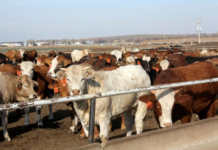Pinkeye prevention and early diagnosis are two keys to cattle eye health in the summer
MANHATTAN, Kan. — Anyone who has experienced dust blowing in their eyes, knows how uncomfortable that can be. In much the same way, cattle’s eyes can be irritated by dust, tall grass, sunlight and flies. In some cases that will cause them to develop pinkeye, said Kansas State Beef Cattle Institute veterinarians on a recent Cattle Chat podcast.
“Cattle with pinkeye often will blink more than normal, and their eyes tear up and appear inflamed,” said Brad White, BCI director and veterinarian. “This is a painful condition and, if left untreated, can cause impaired vision.”
Pinkeye, also known as infectious bovine keratoconjunctivitis, is an infectious disease that peaks in the summer, according to White, who added that calves are more susceptible to this condition than adult cattle. One of the main vectors of the disease is face flies, White said.
The other fly that is common with cattle in the summer is horn flies. White said that face flies are larger in size and fly on and off the animal’s face, while horn flies are smaller and tend to stay on the calf’s body and move with the animal.
“To keep the face flies away, you need to get the insecticide near the calf’s face frequently with either an ear tag or wipes,” veterinarian Bob Larson said.
Veterinarian Brian Lubbers added that pinkeye is hard to prevent and should be approached with a whole herd protocol.
“Because the face flies move around from one calf to another, it can easily spread in the herd,” Lubbers said.
If pinkeye does appear, Lubbers said there are treatment options.
“There are a couple of antimicrobials labeled for pinkeye that work pretty effectively,” he said.
White added if those treatments don’t clear up pinkeye quickly, then it is time to investigate further with a veterinarian.
White said: “If untreated, pinkeye can progress really rapidly. The earlier we catch it and treat it, the better the outcome will be for the animal.”
To hear more of this discussion, listen to the Cattle Chat podcast online.
FOR PRINT PUBLICATIONS: Links used in this story
BCI Cattle Chat podcast, https://ksubci.org/2021/06/25/research-roundup-beef-calves-from-dairy-pinkeye-replacing-corn-with-wheat-cow-vaccinations/
K State Research and Extension is a short name for the Kansas State University Agricultural Experiment Station and Cooperative Extension Service, a program designed to generate and distribute useful knowledge for the well being of Kansans. Supported by county, state, federal and private funds, the program has county extension offices, experiment fields, area extension offices and regional research centers statewide. Its headquarters is on the K State campus in Manhattan. For more information, visit www.ksre.ksu.edu. K-State Research and Extension is an equal opportunity provider and employer.
Story by:
Lisa Moser
785-532-2010
lmoser@ksu.edu
More information:
Bob Larson
785-532-4257
rlarson@vet.k-state.edu
Brian Lubbers
785-532-4012
blubbers@vet.k-state.edu
Brad White
785-532-4243
bwhite@vet.k-state.edu




